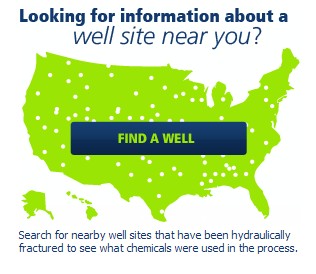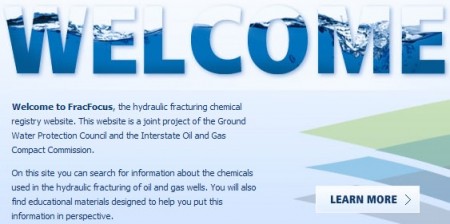Apr
14
Inside Info on Hydraulic Oil and Gas Well Fracturing
April 14, 2011 | 2 Comments
The inestimable and influential Jane Van Ryan of the American Petroleum Institute where a running blog is kept with no less than seven authors offered up Monday a third party site called “FracFocus” run by The Ground Water Protection Council and the Interstate Oil and Gas Compact Commission with the information most everyone but an oil and gas well leaseholder well operator will need.
The new site offers for the first time an information set useful for ordinary folks. Much of the work being done thousands of feet down to crack open more oil and gas production is very valuable and the contractors doing the work are competitive. Just laying out what works at the molecular level is a truly dumb idea if you want to stay ahead in that game.
That makes it something of a surprise to see the new site up and ready for visitors. OK, you’re not going to find trade secrets, but you can come away with lots more know-how than the pabulum offered by the mass media and disinformation the silly opponents to recovering natural resources use to sway impressions their way.
For the terrified the chemicals that might be scary are the adjuvants (makes water ‘wetter’) and bactericides. The rest are really innocents – mostly water and sand. The site has the information on the makeup of fracturing fluid, the need for adjuvants that make the fluid slick and move easily and bactericides that kill corrosion-causing bacteria. The site also lists the various names of the chemicals used to coax oil and natural gas from shale rock formations. With that you’re just steps away from material safety data sheets – also known as the MSDS which are available for practically everything chemical.
If fracturing has been done near you, the website offers visitors a means to obtain a list of the chemicals that have been used at drill sites near their locations.

FracFocus Offers Individual Well Information. Visit the FracFocus site to find out what's going on near you.
To keep things straight and counter the disinformation, the site explains laws that pertain to oil and natural gas field chemical disclosures. There is a section entitled “Chemical and Public Disclosure”. FracFocus points out that oil and natural gas operations are not exempt from Environmental Protection Agency’s toxic inventory and waste management regulations. What you will learn is the EPA has determined that the chemistry used in this segment of the oil and gas industry is not a high priority for reporting. Petroleum discovery and development business doesn’t need to file reports at the federal level because the information is already provided to state agencies that make it publicly available.
Which in turn is now on a fully addressable public website.
Keep in mind one important thing. Of all the worlds’ oil producers – the U.S. is still #3 behind only the Russian Federation and Saudi Arabia. And nowhere is so much information available – right down to the individual well.
Hydraulic fracturing has been used for more than 60 years in the United States in far more than 1 million wells. Combined with horizontal drilling, the pair of technologies is unlocking vast reserves of U.S. oil and natural gas, helping to improve U.S. energy security and keep a harness hold on prices.
The business is also becoming a technology export for the U.S. The premiere technology expertise is among the 9+ million American minds in the oil business. Americans employ millions more overseas.

QuickFrac™ Sleeve Line Up. Click image for the largest view. For more information visit Packers Plus.
And there is no sign of the technology march slowing down. Just last week saw Packers Plus Energy Services Inc. releasing a new technology capable of fracturing 60 stages down the well hole while only pumping 15 treatments at surface. The QuickFrac™ system is a technology that enables operators to increase the number of fractures in a single treatment operation. This system has been successfully proven in the field, and is now commercially available. The procedure is accomplished by taking a single pumping treatment on the surface and precisely directing it into 2-5 stages down the well hole. For the operator, pumping time and costs are reduced significantly and production results are greatly increased. This kind of thing will shift production higher again.
Brian Wang at NextBigFuture offers that North Dakota is likely to increase oil production by another 300,000 to 700,000 barrels per day over the coming years – all due to horizontal drilling and fracturing. Imagine the price of gas if the current half million barrels per day went missing.
Meanwhile exploration is ramping up using American know-how in Australia and France.
If you have concerns, information and knowledge is out there. After over 60 years and a million well fracture procedures you’d think there would be something to merit dismay beyond special interest hysteria. Someday something bad will happen, but will it be before the 2nd million wells or even in the U.S.?
Comments
2 Comments so far



But I thought fracking fluid was 95% Benzene. Isn’t that what they say in Hollywood?
Seriously, I am glad to see someone putting out the real truth. Now, if it can only make it past the faux ‘Green’ truth.
Some may find it interesting that fracfocus.org is run by Brothers & Company, who happens to be a marketing agency providing pro-drilling commercials to companies like Chesapeake.